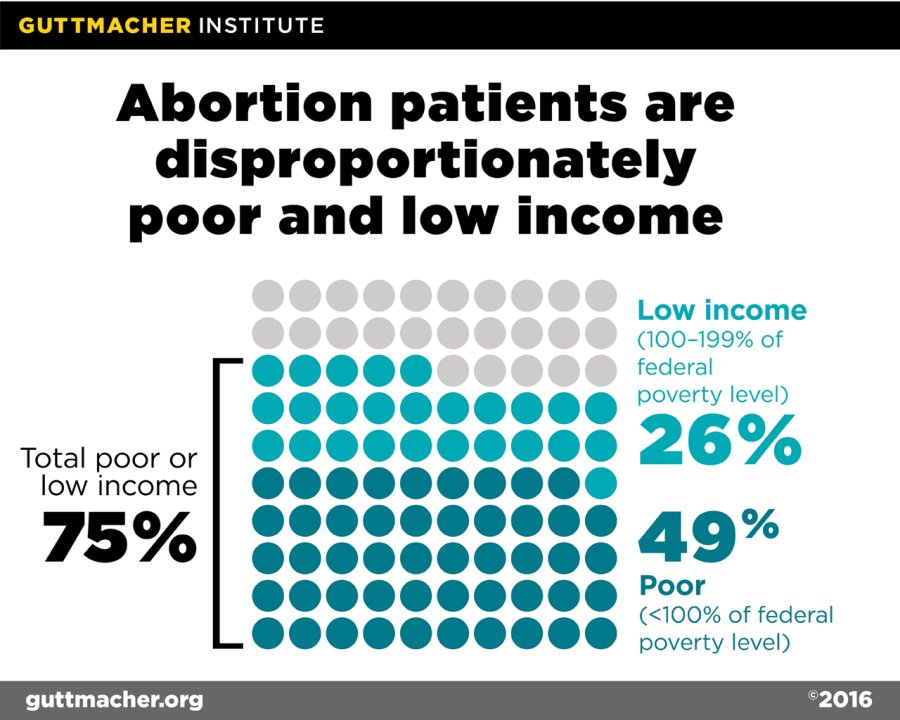Nearly half (49%) of abortion patients in the United States are poor (living below the federal poverty level) and another 26% are low income (living at 100–199% of the federal poverty level), according to "Characteristics of U.S. Abortion Patients in 2014 and Changes Since 2008," by Jenna Jerman, Rachel K. Jones and Tsuyoshi Onda of the Guttmacher Institute. The proportion who are poor has increased since 2008, when 42% of U.S. abortion patients were poor.
"The fact that an increasing proportion of abortion patients are poor is especially significant when you consider the 288 abortion restrictions that were passed between 2009 and 2014," says lead author Jenna Jerman. "These are the individuals hit hardest by those restrictions."
This increase in the proportion of patients who are poor is also reflected in how individuals seeking abortion pay for those services. The proportion of abortion patients who were uninsured declined from 34% in 2008 to 28% in 2014, likely because of the Affordable Care Act. However, having insurance coverage does not necessarily guarantee coverage for abortion services. The Hyde Amendment bans abortion coverage for patients insured by the joint federal-state Medicaid programs except in cases of life endangerment, rape or incest. Some 15 states use their own funds to pay for all or most medically necessary abortions, and in those states, Medicaid has been a key source of funding. Eighty-nine percent of Medicaid patients in those states used their insurance to pay for their abortion procedure in 2014.
However, more than half of abortion patients paid out of pocket, including 61% of those with private insurance. Twenty-five states have laws essentially banning abortion coverage in insurance plans offered through the health insurance exchanges, including 10 states that ban coverage of abortion more broadly in all private insurance plans regulated by the state. And even if insurance covers abortion services, patients may not use it for a variety of reasons—because they do not know their plan covers it, they are concerned about confidentiality or their provider does not accept their plan. The authors note that the inability to use health insurance for abortion services impedes patients’ health and well-being, and disproportionately affects poor and low-income individuals.
"The Hyde Amendment and other restrictions on abortion coverage impact the poorest and most vulnerable populations," says Heather Boonstra, director of public policy. "Abortion is a legal, constitutionally protected and medically appropriate health care service. It’s time to repeal the Hyde Amendment and restore Medicaid coverage for abortion so that every person, regardless of economic circumstances, has the right to decide when and whether to have a child."
The other key finding of this study was that the proportion of abortion patients accounted for by teens (individuals younger than 20) declined by 32% between 2008 and 2014. In 2014, some 12% of abortion patients were teens, and only 4% were minors (individuals younger than 18). As in previous surveys, the majority of abortion patients (60%) were in their 20s, and one-quarter were in their 30s.
Other than income, insurance coverage and age, the characteristics of abortion patients remained relatively unchanged from 2008 to 2014. It is still the case that no racial or ethnic group makes up the majority of abortion patients—39% were white, 28% were black, 25% were Hispanic, 6% were Asian or Pacific Islander, and 3% were another race or ethnicity. In addition, the majority of abortion patients (59%) had had at least one previous birth, and a majority (62%) reported some religious affiliation (including 13% who identified as evangelical Protestant).
For the first time, the survey on which this report is based asked patients about their sexual orientation, and results showed that 94% of abortion patients identified as heterosexual or straight; 4% identified as bisexual, less than 1% as lesbian and 1% as "something else." The authors note that researchers and health care providers should be aware that unintended pregnancy and abortion are not limited to heterosexual women.
About the Survey
This report is based on a nationally representative survey of nonhospital abortion patients in the United States. While the data permitted the researchers to calculate the proportion of abortion patients by demographic characteristic, the report does not provide the number or rate of abortions in the United States for the years 2008–2014. Data on the most recent abortion rates will be forthcoming in 2017 upon release of the results of the Guttmacher Institute’s Abortion Provider Census, which will report the total number of abortions provided in 2013 and 2014. Data for 2011 are currently available here.

